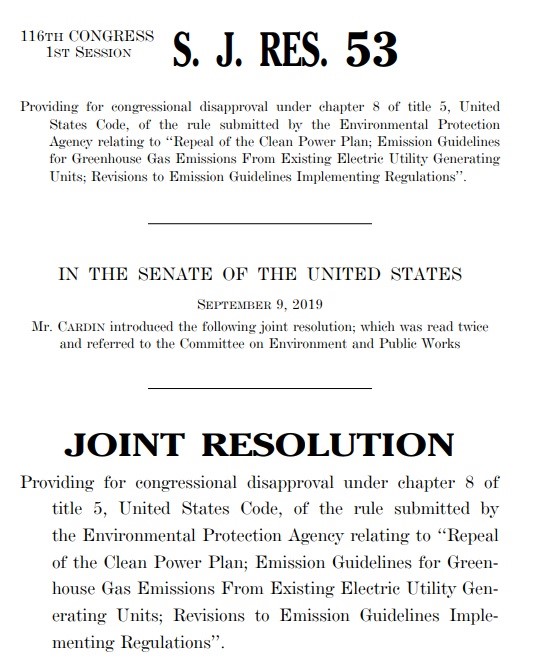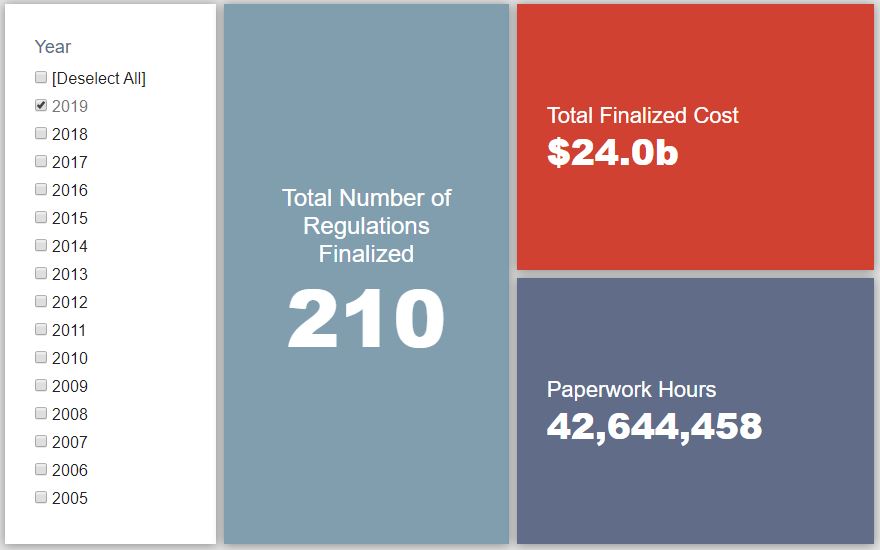Week in Regulation
October 21, 2019
Short Week Yields Marginal Cost Increase
Even considering the four-day workweek, the regulatory haul this past week was noticeably minimal. Most days saw the number of either proposed or final rule documents published in the Federal Register struggle to escape the single-digit level. The slate of rulemakings with a recordable cost or paperwork estimate amounted to just six proposed rules. Across all rulemakings, agencies published $85.1 million in total net costs and added 1,195 hours of annual paperwork.
REGULATORY TOPLINES
- New Proposed Rules: 34
- New Final Rules: 29
- 2019 Total Pages: 55,996
- 2019 Final Rule Costs: $24 Billion
- 2019 Proposed Rule Costs: -$1.9 Billion
TRACKING THE REGULATORY BUDGET
As noted above, the only rulemakings with a quantified cost or savings estimate were in the proposed stage. As such, the regulatory budget picture for fiscal year (FY) 2020 under Executive Order 13,771 remained unchanged. The most notable proposal out of that bunch was a Department of Health & Human Services (HHS) measure on “Revisions To Safe Harbors Under the Anti-Kickback Statute, and Civil Monetary Penalty Rules Regarding Beneficiary Inducements.” HHS estimates that these program changes could lead to “total regulatory review costs of $5.2 million in each of the first 10 years following finalization of the rule.”
For FY 2020, agencies have finalized six deregulatory actions and three regulatory actions, totaling a net $290.2 million in costs. The Trump Administration has yet to release its regulatory budget goal for FY 2020, though it is expected soon.
THIS WEEK’S REGULATORY PICTURE
This week, the Senate votes down a Congressional Review Act (CRA) resolution disapproving of the Affordable Clean Energy (ACE) rule.

With a light week of regulatory activity in the Federal Register, the most notable regulatory happening took place in the Senate, which held a vote on a resolution of disapproval regarding the Environmental Protection Agency’s ACE rule. The resolution was rejected on a 41-53 vote.
The CRA was passed in 1996 and it allows Congress to overturn a final agency rule, rendering it void if both chambers pass the resolution and it is signed by the president. The last requirement limits the CRA substantially, as a president would almost never sign a resolution disapproving of a rule issued by their administration.
Democrats in the Senate utilized expediting procedures allowed under the CRA to bring the resolution to a vote. Those procedures allow 30 senators to discharge a resolution out of committee and bring it to a floor vote. If it comes to the floor within 60 legislative days of when the rule was received by Congress from the agency, then a simple majority can pass the resolution. Alas, only 41 senators ultimately voted in favor of the resolution.
The CRA became a vehicle for political votes like this one, where a presidential signature is a near impossibility, during the Obama Administration. Republicans in the House and Senate held resolution of disapproval votes on several of the Obama Administration’s final rules as one way to publicly demonstrate opposition.
The golden age of the CRA, in terms of it actually being used to overturn rules, occurred in the first year and a half of the Trump Administration. Over that time, 16 rules were overturned as Republicans capitalized on unified control of Congress and the White House to undo Obama-era rules. Prior to that stretch it had only been used successfully once, when President George W. Bush signed a resolution overturning a Clinton Administration rule on ergonomics in the workplace.
TOTAL BURDENS
Since January 1, the federal government has published $22.1 billion in total net costs (with $24 billion in finalized costs) and 47.1 million hours of net annual paperwork burden increases (with 42.6 million coming from final rules). Click here for the latest Reg Rodeo findings.












